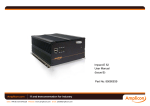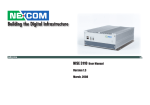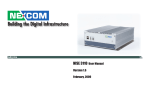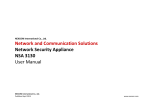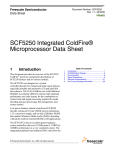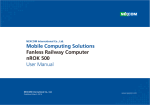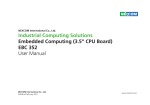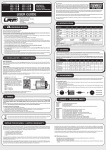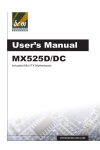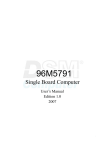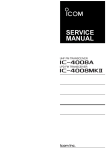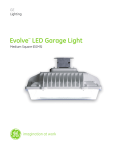Download EBC 340 manual
Transcript
www.nexcom.com Single Board Computer EBC340 User’s Manual Apr.-01-2009 Build User’s Manual is subject to change without prior notice. For any update, please visit our website: www.nexcom.comk Preface Copyright This publication, including all photographs, illustrations and software, is protected under international copyright laws, with all rights reserved. No part of this manual maybe reproduced, copied, translated or transmitted in any form or by any means without the prior written consent from NEXCOM International Co., Ltd. Version 1.3 Copyright 2006 Disclaimer The information in this document is subject to change without prior notice and does not represent commitment from NEXCOM International Co., LTD. However, users may update their knowledge of any product in use by constantly checking its manual posted on our website: http://www.nexcom.com. NEXCOM shall not be liable for direct, indirect, special, incidental, or consequential damages arising out of the use of any product, nor for any infringements upon the rights of third parties, which may result from such use. Any implied warranties of merchantability of fitness for any particular purpose is also disclaimed. Acknowledgements The EBC 340 series is a trademark of NEXCOM international CO., LTD. All other product names mentioned herein are registered trademarks of their respective owners. Regulatory Compliance Statements This section provides the FCC compliance statement for Class A devices and describes how to keep the system CE compliant. Federal Communications Commission (FCC) For Class A Device This equipment has been tested and verified to comply with the limits for a Class A digital device, pursuant to Part 15 of FCC Rules. These limits are designed to provide reasonable protection against harmful interference when the equipment is operated in a commercial environment. This equipment generates, uses, EBC340 User’s Manual 2 Table of Content and can radiate radio frequency energy and, if not installed and used in accordance with the instructions, may cause harmful interference to radio communications. Operation of this equipment in a residential area (domestic environment) is likely to cause harmful interference, in which case the user will be required to correct the interference (take adequate measures) at their own expense. CE Certification The product(s) described in this manual complies with all applicable European Union (CE) directives if it has a CE marking. For computer systems to remain CE compliant, only CE-compliant parts may be used. Maintaining CE compliance also requires proper cable and cabling techniques. WARNINGS Read and adhere to all warnings, cautions, and notices in this guide and the documentation supplied with the chassis, power supply, and accessory modules. If the instructions for the chassis and power supply are inconsistent with these instructions or the instructions for accessory modules, contact the supplier to find out how you can ensure that your computer meets safety and regulatory requirements. CAUTION Electrostatic discharge (ESD) can damage NSA components. Do the described procedures only at an ESD workstation. If no such station is available, you can provide some ESD protection by wearing an antistatic wrist strap and attaching it to a metal part of the computer chassis. Safety Information Before installing and using the EBC340, note the following precautions: Read all instructions carefully. Do not place the unit on an unstable surface, cart, or stand. Follow all warnings and cautions in this manual. When replacing parts, ensure that your service technician uses parts specified by the manufacturer. Avoid using the system near water, in direct sunlight, or near a hearing device. EBC340 User’s Manual 3 Table of Content Table of Content Preface……………...……………..……………………………………….………….……..……………..2 Copyright………………..……………………………………….……………………………………….... 2 Disclaimer………………………..………………………………..……………………………………….. 2 Acknowledgements……………………………………………..………………………..………..…..…… 2 Regulatory Compliance Statements……………………..…………………………………….……………2 Federal Communications Commission (FCC) For Class A Device……………..……….…………..…..…2 CE Certification………………………………………………………………………….……….………...3 Safety Information……………………………………………………………………….………..………..3 Table of Content……………………………………………………………………………………....……. 4 Chapter 1 General Information 1.1 Specification…………………………………………………….…………………………………….. 6 1.2 Power Consumption Measurement……………………………………………………………………..8 1.3 Board Layout…………………………………………………………………….… …………………. 9 1.4 Board Dimensions……………………………………………………….………… …….…………… 9 Chapter 2Jumper Setting 2.1 Before You Begin……………………………………………..….……………………………………11 2.2 Precautions………………………………………………………………………………………... …..11 2.3 Setting Jumpers…………………………………………………………………………………… …..12 2.4 Location of Jumpers………………………………………………………………………………. …..13 2.5 Function of Jumpers and Connectors…………….………………………………………………........14 GPIO Programming Guide………………………………………………………………………………28 Chapter 3 Expansion 3.1 System Memory…………………………………………………………………………………..…….31 3.2 Installing Compact Flash……………….……...………………………………………..…………….. 32 Chapter 4 BIOS Setting 4.1 Entering Setup………………………………………………………………………………………….34 4.2 Getting Help……………………………………………………………………………………………34 4.3 The Main Menu………………………………………………………………………………………...36 EBC340 User’s Manual 4 Table of Content Chapter 1 General Information EBC340 User’s Manual 5 Chapter 1 1.1 Specification CPU Support Intel® Atom™ Processor N270 1.6GHZ Main Memory 1 x DDR2 SO-DIMM Socket (up to 1GB) Chipset Intel 945GSE Express chipset Intel® 82801GBM (ICH7-M) Graphic Intel® 945GSE integrated graphics Support Dual Independent Display:CRT+LVDS CRT: 1 x DB15 VGA CON LVDS: 1x DF13 20-pin connector Storage Support 1x Type I/II Compact Flash socket EBC340 User’s Manual 6 Chapter 1 uDOC mechanical dimension to support USB interface SSD 1x 7-pin SATA connector Expansion 1x PCI-104 Audio Realtek ALC888 CODEC Mic-In x1 / Line out x1 Phone Jack Network LAN Chip: Realtek RTL8111C-GR Support Boot From LAN (PXE) I/O 1 x Parallel Port 26-pin Box header COM1 by DB9 Male CON COM2 support RS232/422/485 w/10pin Box header 2 x 10pin Box Header for COM3~COM4 1 x USB 2.0 Port 1 x 2.0mm Jst Connector for USB 1 x 10Pin Header for USB 1 x 10pin header for GPIO 1 x Power LED pin header 1 x HDD Active LED Pin header 1 x LAN Link-Active LED Pin header 1 x 3pin fan connector(Reserved) Power Supply +12V/+5V AT/ATX mode 6pin Power CON System Management Derived from Super I/O to support system monitor Monitoring of 5 voltages For +5V, Vcore,+12V, +3.3V, +1.5V5 voltage 2 Temperatures (CPU, System) RTC On chip RTC with battery back up / External Li-ion Battery RTC Torrance less than 2sec (24 hours) under 25˚C BIOS Award system BIOS 8M bits SPI ROM Operating Systems Windows XP,XP Embedded, CE Certification CE EBC340 User’s Manual 7 Chapter 1 FCC Class A 100% RoHS competed Environment Operating temperatures: 0°C to 60°C Storage temperatures:-20˚C to 85˚C Relative Humidity: Operating 10%~90%, non-condensing 1.2 Power Consumption Measurement EBC340 Power Consumption Power Type Consumed watts +12V +5v +12v-to-Vcore +12v-to-1.8v +12v-to-0.9v 5v-to-1.5v 5v-to-1.05v +12v-to-3.3v DC/DC DC/DC DC/DC DC/DC DC/DC DC/DC 18W 34.75W 4.4W 5.544W 0.9W 5.79W 7.581W 19W 1.5A 6.95A 0.367A 0.462A 0.075A 1.158A 1.5162A 1.584A 0.46A 0.578A 0.01A 1.448A 1.896A 1.98A Consumed currents (Item A ) Actually required currents (Item A/0.80 ) 12v needed 4.528A 5v needed 10.294A EBC340 User’s Manual 8 Chapter 1 1.3 Board Layout Figure 1.2: Overview of EBC 340 1.4 Board Dimensions Figure 1.3: Mechanical Drawing of the EBC 340 EBC340 User’s Manual 9 Chapter 1 Chapter 2 Jumper Setting EBC 340 User’s Manual 10 This chapter of the User’s Manual describes how to set jumpers. Note: The procedures that follow are generic for all EBC340. 2.1 Before You Begin Ensure you have a stable, clean working environment. Dust and dirt can get into components and cause a malfunction. Use containers to keep small components separated. Adequate lighting and proper tools can prevent you from accidentally damaging the internal components. Most of the procedures that follow require only a few simple tools, including the following: ♦ A Philips screwdriver ♦ A flat-tipped screwdriver ♦ A set of jewelers Screwdrivers ♦ A grounding strap ♦ An anti-static pad Using your fingers can disconnect most of the connections. It is recommended that you do not use needle-nosed pliers to disconnect connections as these can damage the soft metal or plastic parts of the connectors. Before working on internal components, make sure that the power is off. Ground yourself before touching any internal components, by touching a metal object. Static electricity can damage many of the electronic components. Humid environment tend to have less static electricity than dry environments. A grounding strap is warranted whenever danger of static electricity exists. 2.2 Precautions Computer components and electronic circuit boards can be damaged by discharges of static electricity. Working on the computers that are still connected to a power supply can be extremely dangerous. Follow the guidelines below to avoid damage to your computer or yourself: ♦ Always disconnect the unit from the power outlet whenever you are working inside the case. ♦ If possible, wear a grounded wrist strap when you are working inside the computer case. Alternatively, discharge any static electricity by touching the bare metal chassis of the unit case, or the bare metal body of any other grounded appliance. ♦ Hold electronic circuit boards by the edges only. Do not touch the components on the board unless it is necessary to do so. Don’t flex or stress the circuit board. ♦ Leave all components inside the static-proof packaging that they shipped with until they are ready for installation. ♦ Use correct screws and do not over tighten screws. EBC 340 User’s Manual 11 2.3 Setting Jumpers A jumper is the simplest kind of electric switch. It consists of two metal pins and a cap. When setting the jumpers, ensure that the jumper caps are placed on the correct pins. When the jumper cap is placed on both pins, the jumper is SHORT. If you remove the jumper cap, or place the jumper cap on just one pin, the jumper is OPEN. Please see the following illustrations The illustrations on the right show a 2-pin jumper. When the jumper cap is placed on both pins, the jumper is SHORT. If you remove the jumper cap, or place the jumper cap on just one pin, the jumper is OPEN. Open (Off) These illustrations show a 3-pin jumper. Pins 1 and 2 are SHORT. Table 2-1: Setting Jumpers EBC 340 User’s Manual 12 Short (On) 2.4 Location of Jumpers Figure 2-1: Jumper Location EBC 340 User’s Manual 13 2.5 Functions of Jumpers and Connectors ◎ VGA Port VGA1 (D-Sub 15 pins) Pin Definition: VGA1 Pin NO. Description Pin NO. Description 1 RED_VGA 9 VGA_VCC 2 GREEN_VGA 10 GND 3 BLUE_VGA 11 NC 4 NC 12 VGA_DDC_DATA 5 GND 13 G_HSYNC 6 GND 14 G_VSYNC 7 GND 15 VGA_DDC_CLK 8 GND ◎ LVDS CON CN6 ( 2 X10 2.0 Pitch) Pin Definition: CN6 Pin NO. Description Pin NO. Description 1 DDCCLK 11 LB_CLK_P 2 DDC_DATA 12 LB_DATAN1 3 VDD 13 LB_CLK_N 4 LB_DATAP0 14 GND 5 PULL LOW 15 GND 6 LB_DATAN0 16 VCC12_INV 7 PULL LOW 17 LB_DATAP2 8 VDD 18 VCC12_INV 9 GND 19 LB_DATAN2 10 LB_DATAP1 20 GND EBC 340 User’s Manual 14 ◎ CCFL CON J4 (JST 7 Pins 2.54 Pitch) Pin Definition: J4 Pin NO. Description Pin NO. Description 1 +5V 2 +12V 3 +12V 4 Brightness Ctrl 5 GND 6 GND 7 Backlight Enable ◎Panel Power selection: Pin header 1x3 2.54 Pitch. Pin Definition: JP8 Pin NO. Description 1 VCC5 2 Panel power 3 VCC3 ◎ RTC Clear: Pin header 1x3 2.54 Pitch. Pin Definition: JP2 Pin NO. Description 1 Battery 3.3V 2 RTCRST# 3 GND ◎ Reset Button: Pin header 1x2 2.0 Pitch. Pin Definition: JP1 EBC 340 User’s Manual 15 Pin NO. Description 1 RESET# 2 GND ◎ HDD Active LED: Pin header 1x2 2.0 Pitch. Pin Definition: JP3 Pin NO. Description 1 VCC5 2 HD_LED# ◎Power LED: Pin header 1x2 2.0 Pitch. Pin Definition: JP4 Pin NO. Description 1 VCC5 2 GND ◎ SMBus: Pin header 1x2 2.0 Pitch. Pin Definition: JP5 Pin NO. Description 1 SMB_DATA 2 SMB_CLK ◎ LAN Active LED Pin header 1x2 2.0 Pitch. EBC 340 User’s Manual 16 Pin Definition: JP6 Pin NO. Description 1 VCC3 2 LAN1_ACTLED# ◎ LAN Link LED Pin header 1x2 2.0 Pitch. Pin Definition: JP7 Pin NO. Description 1 VCC3 2 LAN1_LINKLED# ◎P/S 2 Keyboard / Mouse Pin header 2x4 2.54 Pitch. Pin Definition: JP9 KM1 FOR KEYBOARD/ MOUSE: Pin NO. Description Pin NO. Description 1 VCC5 2 VCC5 3 KB_DATA 4 LM_DATA 5 KB_CLK 6 LM_CLK 7 GND 8 GND EBC 340 User’s Manual 17 ◎ PCI104 Connector A. Connector size: 4X30 pin B. Connector location: CN1 C. Connector pin definition: Pin Signal Pin Signal PA1 GND PC1 VCC5 PA2 VIO PC2 PCI_AD1 PA3 PCI_AD5 PC3 PCI_AD4 PA4 PCI_CBE#0 PC4 GND PA5 GND PC5 PCI_AD8 PA6 PCI_AD11 PC6 PCI_AD10 PA7 PCI_AD14 PC7 GND PA8 VCC3 PC8 PCI_AD15 PA9 PCI_SERR# PC9 NC PA10 GND PC10 VCC3 PA11 PCI_STOP# PC11 PCI_LOCK# PA12 VCC3 PC12 GND PA13 PCI_FRAME# PC13 PCI_IRDY# PA14 GND PC14 VCC3 PA15 PCI_AD18 PC15 PCI_AD17 PA16 PCI_AD21 PC16 GND PA17 VCC3 PC17 PCI_AD22 PA18 PCI_104_IDSEL0 PC18 PA19 PCI_AD24 PC19 VIO PA20 GND PC20 PCI_AD25 PA21 PCI_AD29 PC21 PCI_AD26 PA22 VCC5 PC22 GND PA23 PCI_REQ#2 PC23 PCI_REQ#3 PA24 GND PC24 VCC5 PA25 PCI_GNT#3 PC25 PCI_GNT#4 PA26 VCC5 PC26 GND PA27 PCI_CLK2 PC27 PCI_CLK3 EBC 340 User’s Manual 18 PCI_104_IDSEL 1 PA28 GND PC28 VCC5 PA29 VCC12 PC29 PCI_IRQ#F PA30 VCC12N PC30 PCI_GNT#5 PB1 NC PD1 PCI_AD0 PB2 PCI_AD2 PD2 VCC5 PB3 GND PD3 PCI_AD3 PB4 PCI_AD7 PD4 PCI_AD6 PB5 PCI_AD9 PD5 GND PB6 VIO PD6 GND PB7 PCI_AD13 PD7 PCI_AD12 PB8 PCI_CBE#1 PD8 VCC3 PB9 GND PD9 PCI_PAR PB10 PCI_PERR# PD10 NC PB11 VCC3 PD11 GND PB12 PCI_TRDY# PD12 PCI_DEVSEL# PB13 GND PD13 VCC3 PB14 PCI_AD16 PD14 PCI_CBE#2 PB15 VCC3 PD15 GND PB16 PCI_AD20 PD16 PCI_AD19 PB17 PCI_AD23 PD17 VCC3 PB18 GND PD18 PB19 PCI_CBE#3 PD19 PB20 PCI_AD26 PD20 GND PB21 VCC5 PD21 PCI_AD27 PB22 PCI_AD30 PD22 PCI_AD31 PB23 GND PD23 VIO PB24 PCI_REQ#4 PD24 PCI_GNT#2 PB25 VIO PD25 GND PB26 PCI_CLK0 PD26 PCI_CLK1 PB27 VCC5 PD27 GND PB28 PCI_IRQ#H PD28 PCI_RST# PB29 PCI_IRQ#E PD29 PCI_IRQ#G PB30 PCI_REQ#5 PD30 GND D. PCI routing : AD20 : E F G H AD21 : H E F G AD22 : G H E F EBC 340 User’s Manual 19 PCI_104_IDSEL 2 PCI_104_IDSEL 3 AD23 : F G H E EBC 340 User’s Manual 20 ◎ SATAII ports J1 Standard Serial ATAII 1.27mm connector 1 7 Pin definition: J1 Pin NO. Description Pin NO. Description 1 GND 2 TXP0 4 GND 3 TXN0 7 GND 5 RXN0 6 RXP0 ◎COM 1 A. Connector size: 2 X 20 = 40 Pin B. Connector location: JP1 Connector pin definition Pin Signal 1 DCD 2 RXD 3 TXD 4 DTR 5 GND 6 DSR 7 RTS 8 CTS 9 RI ◎ COM 2~4: Box header 2x10 2.0 Pitch EBC 340 User’s Manual 21 CN4 , CN2 , CN3 Connector pin definition Pin Signal 1 DCD 2 RXD 3 TXD 4 DTR 5 GND 6 DSR 7 RTS 8 CTS 9 RI 10 NC ◎COM2 selection: SW1. 1-20 2-19 3-18 4-17 5-16 6-15 7-14 8-13 9-12 10-11 RS232 OFF OFF OFF ON OFF ON OFF OFF OFF OFF RS422 OFF OFF ON OFF ON OFF ON ON ON ON RS485 ON OFF ON ON OFF OFF OFF OFF ON ON EBC 340 User’s Manual 22 ◎ Compact Flash CN10 (Compact Flash TYPE 2) Pin Definition: Pin NO. Description Pin NO. Description 1 GND 2 SDD3A 3 SDD4A 4 SDD5A 5 SDD6A 6 SDD7A 7 SDCS#1 8 GND 9 GND 10 GND 11 GND 12 GND 13 VCC 14 GND 15 GND 16 GND 17 GND 18 SDA2A 19 SDA1A 20 SDA0A 21 SDD0A 22 SDD1A 23 SDD2A 24 NC 25 CF_CD2# 26 CF_CD1# 27 SDD11A 28 SDD12A 29 SDD13A 30 SDD14A 31 SDD15A 32 SDCS#3 33 NC 34 SDIOR# 35 SDIOW# 36 VCC 37 HDIRQ14 38 VCC 39 CF_SEL# 40 NC 41 IDERST# 42 SIORDY 43 SDREQ 44 SDDACK# 45 IDEACTP# 46 DIAG# 47 SDD8A 48 SDD9A EBC 340 User’s Manual 23 49 SDD10A 50 GND ◎ USB Port CN7 Dual USB port. Pin Definition: CN7: Pin NO. Description Pin NO. Description 1 P5V_USB_P01 5 P5V_USB_P01 2 USB0- 6 USB1- 3 USB0+ 7 USB1+ 4 GND 8 GND ◎ Parallel Interface CN5 (2.0mm Box Header) Pin Definition: CN5 Pin NO. Description Pin NO. Description 1 STB# 14 AFD- 2 PD0 15 ERR- 3 PD1 16 INIT- 4 PD2 17 SLIN- 5 PD3 18 GND 6 PD4 19 GND 7 PD5 20 GND 8 PD6 21 GND 9 PD7 22 GND 10 ACK- 23 GND EBC 340 User’s Manual 24 11 BUSY 24 GND 12 PE 25 GND 13 SLCT 26 NC ◎GPIO connector 2 x 5 2.0mm Pin header Pin Definition: J5 1 VCC5 2 GND 3 SIO_GPI54 4 SIO_GPO50 5 SIO_GPI55 6 SIO_GPO51 7 SIO_GPI56 8 SIO_GPO52 9 SIO_GPI57 10 SIO_GPO53 ◎ USB Jst Connector JST 6 Pins 2.0 Pitch Pin Definition: J6 Pin NO. Description 1 P5V_USB_P23 2 USB2- 3 USB2+ 4 USB3- 5 USB3+ 6 GND EBC 340 User’s Manual 25 ◎ SYSTEM FAN. FAN (Wafer-2.54mm Male 180) Pin Definition: FAN1 Pin NO. Description 1 GND 2 12V 3 SENSE ◎ DC Power input Connector: 1x 6 Pin Power connector: Pin Definition: J2 Pin NO. Description 1 VCC12 2 GND 3 GND 4 GND 5 VCC5 6 VCC5 ◎ ATX power connector 1X3 JST 2.5mm Connector Pin Definition: J3 Pin NO. Description EBC 340 User’s Manual 26 1 NC 2 GND 3 PS_ON# ◎USB DOM Connector: Pin Headr 2x5 2.54mm Pitch Pin Definition: J7 Pin Signal Pin Signal 1 P5V_USB_P45 2 P5V_USB_P45 3 USB4- 4 USB5- 5 USB4+ 6 USB5+ 7 GND 8 GND 9 NC 10 uDOC_OC# ◎ Line-Out Connector: CN8 Phone Jack Pin NO. ON 1 GND 2 LOUT_R 3 NC 4 NC 5 LOUT_L ◎ Mic-In Connector: CN9 Phone Jack EBC 340 User’s Manual 27 Pin NO. ON 1 GND 2 MIC_R 3 NC 4 NC 5 MIC_L ◎ LAN1 connector: A. Connector size: RJ45+LED B. Connector location: CN8 C. Connector pin definition Pin Signal Pin Signal 1 LAN1_TXD0P 2 LAN1_TXD0N 3 LAN1_TXD1P 4 LAN1_TXD2P 5 LAN1_TXD2N 6 LAN1_TXD1N 7 LAN1_TXD3P 8 LAN1_TXD3N 9 LAN1_LINKLED# 10 VCC3 11 LAN1_ACTLED# 12 VCC3 MH1 GND_CHASSIS MH2 GND_CHASSIS EBC 340 User’s Manual 28 GPIO Programming Guide: EBC 340 User’s Manual 29 EBC 340 User’s Manual 30 Chapter 3 Expansion EBC 340 User’s Manual 31 3.1 System Memory EBC 340 incorporates Intel 945GSE Express chipset chipset supports up to 1GB un-buffered non-ECC DDR2 SDRAM. Installing memory 1.To install a memory into socket,insert it to socket notches. 2.Then press the memory down until completely seated within the springs. EBC 340 User’s Manual 32 3.2 Installing Compact Flash 1. To install a Compact Flash memory card into EBC 320-JB, align the notches on the card with the Compact Flash socket in the EBC 320-JB. Then firmly insert the card into the socket until it is completely seated. Figure 3-5: How to Install Compact Flash Memory (1) 2. To remove the Compact Flash memory card from EBC 340, pull out the memory card from the Compact Flash socket. Figure 3-6: How to Uninstall Compact Flash Memory (2) EBC 340 User’s Manual 33 Chapter 4 BIOS Setting EBC 340 User’s Manual 34 AWARD BIOS Setup Award's BIOS ROM has a built-in Setup program that allows users to modify the basic system configuration. This type of information is stored in battery-backed RAM (CMOS RAM) so that it retains the Setup information when the power is turned off. The Chapter shows the currently BIOS setup picture is for reference only, which may change by the BIOS modification in the future. Any Major updated items or re-version, user can download from NEXCOM web site http://www.nexcom.com.tw or any unclear message, can contact NEXCOM Customer Service people for help http://www.nexcom.com.tw/contact/contact.htm 4.1 Entering Setup Power on the computer and press <Del> immediately will allow you to enter Setup. The other way to enter Setup is to power on the computer, when the below message appears briefly at the bottom of the screen during the POST (Power On Self Test), press <Del> key TO ENTER SETUP BEFORE BOOT PRESS <DEL> KEY 4.2 Getting Help Main Menu The on-line description of the highlighted setup function is displayed at the bottom of the screen. Sub-Menu If you find a right pointer symbol appears to the left of certain fields (as shown in the right view), that means a sub-menu containing additional options for the field can be launched from this field. To enter the sub-menu, highlight the field and press <Enter>. Then you can use control keys to move between and change the settings of the sub-menu. To return to the main menu, press <Esc> to trace back. EBC 340 User’s Manual 35 Status Page Setup Menu/Option Page Setup Menu Press <F1> to pop up a small help window that describes the appropriate keys to use and the possible selections for the highlighted item. To exit the Help Window press <Esc>. EBC 340 User’s Manual 36 4.3 The Main Menu Once you enter Award BIOS CMOS Setup Utility, the Main Menu (Figure 1) will appear on the screen. The Main Menu allows you to select from ten setup functions and two exit choices. Use arrow keys to select among the items and press <Enter> to accept or enter the sub-menu. It is recommended to load the Defaults for “Optimized” . Standard CMOS Features Use this menu for basic system configuration. Advanced BIOS Features Use this menu to set the Advanced Features available on your system. Integrated Peripherals Use this menu to specify your settings for integrated peripherals. Power Management setup EBC 340 User’s Manual 37 Use this menu to specify your settings for power management PNP/PCI Configuration This entry appears if your system supports PnP / PCI. PC health Status Display CPU/System Temperature, Fan speed. Load Optimized Defaults Use this menu to load the BIOS default values that are factory settings for optimal Uperformance system operations. While Award has designed the custom BIOS to maximize performance, the factory has the right to change these defaults to meet their needs. Set Password Enter and change the options of the setup menus. If password error or disable, some read only INFO will be displayed on the menu. Save & Exit Setup Save CMOS value changes to CMOS and exit setup. Exit Without Saving Abandon all CMOS value changes and exit setup. EBC 340 User’s Manual 38







































